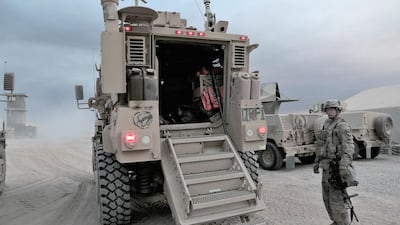QAYYARAH, IRAQ // As night falls, a line of men and women in combat fatigues forms behind the blast walls shielding the canteen.
The biggest queue is for the tent serving fast food: burgers, sandwiches and hash browns. Some opt for boil-in-the bag meals dished out of vats in the mobile kitchen. Apart from the cooks, everyone is carrying a gun.
This is Qayyarah Air Field West, barely 60 kilometres from Mosul, where the battle against ISIL is raging. The shot up buildings and the carcass of an exploded armoured car near the camp entrance are reminders that the war against ISIL has been going on for two-and-a-half years.
But while Iraqi forces in Mosul are engaged in some of the fiercest fighting yet, in Qayyarah, monotony reigns. Air strikes and artillery support for the Iraqis are coordinated from the airbase but the soldiers of the 101st Airborne Division have no active combat role in the battle for Mosul.
Dinner options aside, camp life has its limitations. “We work out a lot,” says a pale, lanky soldier sitting outside one of the four mess tents.
As dusk settles on the barren land, soldiers shake off the boredom with an evening run along the blast walls lining the perimeter. Others say they use the down time to study.
The 101st Airborne first set up base in Qayyarah in 2003 during the Second Gulf War, and established themselves in what is known as Forward Operating Base Endurance before the US military pulled out of the country in 2011.
After Iraqi special forces retook the town and the base in July, the Americans returned to assist in defeating ISIL. The airbase became a key command and logistics centre of the Mosul Operation, launched on October 17.
Military engineers repaired the air strip and now close to 1,000 coalition troops are based in Qayyarah, sharing the base with the Iraqi army — which throws up some interesting contrasts.
Rules and regulations are paramount in the US compound. Every tent and container is erected according to a set plan and protected by perfectly-placed concrete blast walls.
Inside, U-shaped concrete blocks arch over each bed with additional blast walls at each end. A High Mobility Artillery Rocket System, or HIMARS, is parked in a concrete shelter nicknamed Rocket City. A forest of antennas and communication towers complete the picture of military sophistication.
The protocol can seem absurd.
Miles behind the front line, many soldiers wear full combat gear of flak jacket, helmet, ammunition clips and an M4 rifle. Mine-Resistant Ambush Protected vehicles include a turret gunner even for short journeys around the base.
Chatty kitchen staff serve up fried meat dumplings, salad and bread to anyone who enters the officers mess, one of the many containers lined up in the sprawling Iraqi army compound.
“We wouldn’t want a soldier to go hungry,” quips US army spokesman Major Chris Parker.
While there is no danger of food running out, regulations also deny visiting journalists dinner.
On the Iraqi side, such lack of hospitality would be unthinkable.
Men go about in uniform or civilian clothing, and shuffle to the portaloos in their pyjamas after rising in the morning. Only officers get the privacy of containers — the rest are in huge tents. Battered old Humvees share parking space with the flatbed lorries that carry heavy machine guns.
The two worlds collide in the Combined Joint Operations Centre, or what Maj Parker calls “the nerve centre where a lot of the information for the Mosul operation comes together”.
Here, Iraqi and US operators sit side by side facing screens showing aerial images of military targets.
On the American side of the tent, clean shaven, muscular young men shout information into phone headsets or at each other, while constantly monitoring their computers for updates.
On the Iraqi side, the atmosphere is more relaxed — no computers, just predominantly middle-aged officers with moustaches and pot bellies leaning back in their chairs and scrolling through their smart phones.
A fireball on one of the screens draws everyone’s attention. The Americans react with the knowing confidence of football fans watching their team score again in a one-sided contest. The Iraqis are less clued up.
“Was that artillery?” asks an Iraqi officer. “That was an air raid,” comes the answer.
The artillery comes later, when quiet has settled over the base. In the early hours, a series of loud booms tear through the air, as howitzers open up on an enemy miles in the distance. A little later, a second salvo of shells blasts into the sky, their flight path straddling the Tigris before descending onto an ISIL position near Mosul.
The soldiers at Qayyarah Air Field West are used to such interruptions to their slumber. Turning in their field beds, most will be asleep again when the artillery rounds hit their targets.
foreign.desk@thenational.ae

